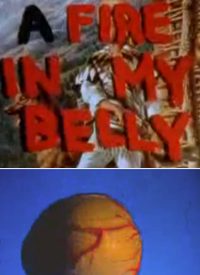
Having been pulled from an exhibition at the Smithsonian Institution, a film which features ants crawling on a crucifix and a man stitching his mouth together will go on display as part of a larger homosexual exhibit at the Brooklyn Museum in Brooklyn, New York.
The nation’s second largest art museum, CNSNews.com reported last week, will feature A Fire In My Belly, a film by David Wojnarowicz, a homosexual producer who unsurprisingly died of AIDS, within an exhibit titled “Hide and Seek.”
“Hide and Seek” appeared at the Smithsonian at last year, subsidized by federal tax dollars, but the museum pulled the film after GOP elected officials complained. Now the Brooklyn Museum, also funded by state, federal, and city tax dollars, will show the film.
Christmas Blasphemy
Part of the larger “Hide and Seek” exhibit, which landed just before Christmas last year at the Smithsonian’s National Portrait Gallery, A Fire in My Belly, critics note, is an amateurish attempt to say something, but about the only message it imparts is that its homosexual creator was a disturbed and tortured soul for whom a viewer should feel pity.
As CNS described the film, “[t]he four-minute version of the video shown in the exhibit at the National Portrait Gallery shows, among other images, ants crawling over the image of Jesus on a crucifix, two halves of a loaf of bread being sewn together, the bloody mouth of a man being sewn shut, a hand dropping coins, a man undressing, a man’s genitals, a bowl of blood, and mummified humans.”
CNS also divulged some of the demented catalog material the Smithsonian published with taxpayer money:
A portrait of the video’s creator David Wojnarowicz, buried up to his face, is also in the exhibit. The catalog description says of the image: “Here, on the brink of a premature death, Wojnarowicz is at once disappearing peacefully into the American landscape and being violently suffocated by it.”
The Smithsonian-published catalog also notes (p. 54) that “Wojnarowicz earned a reputation for public, and for many, an utterly cathartic, portrait of rage.” It then quotes a passage from Wojnarowicz’s 1991 book, Close to the Knives: A Memoir of Disintegration, in which the artist writes of daydreaming about shooting darts dipped in HIV-positive blood into the necks of politicians and expresses his enmity for “walking swastikas that wear religious garments.”
“… and I’m waking up more and more from daydreams of tipping Amazonian blowdarts in ‘infected blood’ and spitting them at the exposed necklines of certain politicians or government healthcare officials or those thinly disguised walking swastikas that wear religious garments over their murderous intentions.”
The Smithsonian dropped the film after complaints from House Speaker John Boehner (R-Ohio) and House Majority Leader Eric Cantor (R-Va.), who objected to using of taxpayers dollars to show a film patently offensive to Christians. Boehner threatened the Smithsonian’s federal funding.
Said Cantor, who is Jewish, “This is an outrageous use of taxpayer money and an obvious attempt to offend Christians during the Christmas season. When a museum receives taxpayer money, the taxpayers have a right to expect that the museum will uphold common standards of decency. The museum should pull the exhibit and be prepared for serious questions come budget time.”
Though the Smithsonian surrendered and removed the film from “”Hide and Seek,” the rest of the revolting “art exhibit” remained. It featured a strange photo of lesbian celebrity Ellen Degeneres holding her breasts and two naked brothers kissing each other on the mouth, with one holding a gun to the other’s chest.
Another photograph by deceased homosexual artist Robert Mapplethorpe featured two sadomasochistic homosexuals. Mapplethorpe became famous in the early 1990s when the public learned that tax dollars from the National Endowment for the Arts funded a traveling exhibit of his work that included his self-portrait, which depicted a bullwhip in his rectum. Mapplethorpe’s genius also included images of coprophagia.
The curator of the gallery justified the museum’s exhibition, telling CNS that “[i]n our special, themed exhibitions, we have the opportunity to explore additional questions about American identity, history and culture.” As well, the curator said:
Hide/Seek evolved from the Portrait Gallery’s ongoing commitment to represent the diversity of our people in recognizing the contribution that gay and lesbian Americans made to American art and culture during the last century. …
[W]e wanted to show how concepts of gender, sexuality, and identity are fluid and changing, evolving over time and under different circumstances.
We wanted to explore the idea of identity historically, going back to the late nineteenth century and then tracing how the art evolved in response to the development of modern society as well as how individuals coped with the pressures of modern life.
Although “Hide and Seek” had no message, he told CNS, “What it asks us to do is to expand our understanding of what we think we know, whether that be art or American history. In particular, it asks us to consider how being marginalized or excluded by the mainstream, normative culture led gay and lesbian artists to create portraiture that was particularly insightful and responsive to the modern condition.”
Brooklyn’s Blasphemy
The Brooklyn Museum’s exhibition of “Hide and Seek” and A Fire in My Belly, which opens Nov. 18, is not the publicly-funded museum’s first dalliance with obscenity and blasphemy.
The museum created a national outrage in 1999 with a piece titled “The Holy Virgin Mary,” a painting of a black Madonna that used elephant dung to represent an exposed breast. It was part of a larger exhibition titled “Sensation,” and it invited a lawsuit from then-Mayor Rudolph Guiliani. Salon.com defended the painting by noting that elephants and their excrement are sacred in Africa and other parts of the world. Except that the artist is a black Catholic Briton, of Nigerian heritage, born in Manchester.
Bill Donohue, of the Catholic League For Religious and Civil Rights, says his organization will not campaign against the museum’s showing the offensive film. “We can’t be like in a dog and pony show every time they show the stupid video,” he told the New York Daily News.
But Donohue did attack museum director Arnold Lehman, who had defended the anti-Christian film by telling the Daily News, “For a city that prides itself on diversity and creativity, there couldn’t be a better exhibition.” Replied Donohue, “For Arnold Lehman, there is no such thing as anti-Catholic art. Catholics who disagree are apparently too stupid to appreciate the complexities of these masterpieces.” Donohue continued,
[H]e [Lehman] says that a video featuring large ants crawling all over Jesus on the Cross is actually a statement about “human suffering and death.” Guess us stupid Catholics missed that one, too.
Better yet is John Tamagni, the chairman of BMA’s board. In response to a letter by Brooklyn Bishop Nicholas DiMarzio, who properly asked the video to be pulled, Tamagni said, “Nothing in the exhibition was meant to be offensive.” This would include such spectacular fare as full frontal male nudity; scenes of naked men kissing; sado-masochistic images; and photos of AIDS-ravaged corpses. Perhaps they were meant to ennoble. Guess us stupid Catholics missed that one, too.
The fact is that the artist who made the vile video died of self-inflicted wounds: he died of AIDS. The homosexual, David Wojnarowicz, hated the Catholic Church (had he lived by its teachings, he would not have self-destructed). He once referred to Cardinal John O’Connor as a “fat cannibal,” and labeled the Catholic Church a “house of walking swastikas.” Sounds like the words of a bigot. But perhaps I’m too stupid not to understand that they were really meant to endear the artist to the Catholic community.
According to the Brooklyn Museum’s website, Lehman’s first official act as director was “to march in Brooklyn’s West Indian Labor Day Parade.” That annual parade, as The New American has reported, is a riotous bacchanal featuring heavy drinking, overt carnality, violence, and gunplay.



